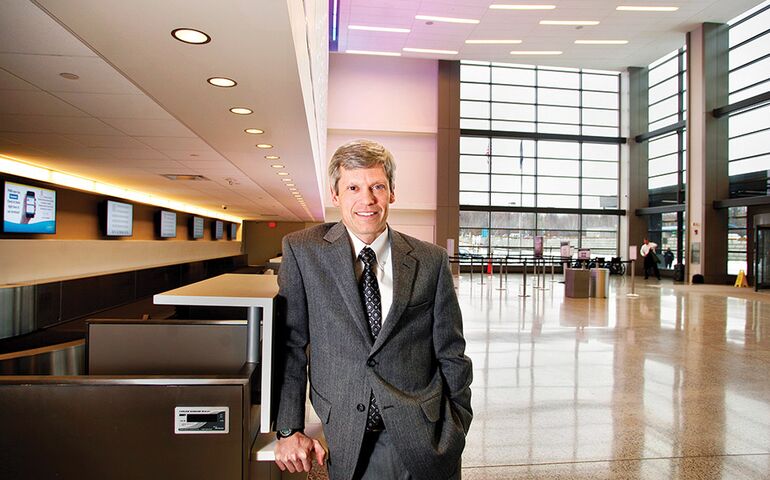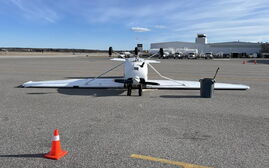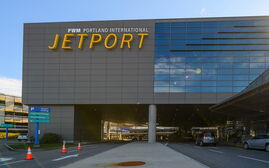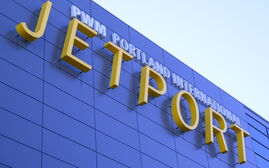PWM courts new airlines
 Photo/Tim Greenway
Airport Director Paul Bradbury stands in the new wing of the Portland International Jetport in February 2012. The jetport hosted a national conference to recruit new carriers last week.
Photo/Tim Greenway
Airport Director Paul Bradbury stands in the new wing of the Portland International Jetport in February 2012. The jetport hosted a national conference to recruit new carriers last week.
With a $75 million expansion complete and a new airport terminal to fill, the Portland International Jetport is boosting its recruitment of new airlines. And "speed dating" is a part of that strategy.
Over three days last week, PWM became a major hub for regional airports, hosting representatives from 12 airlines and 35 airports across the country for the third annual Eastern Airports Conference.
Hosting this year's conference gives new airlines a chance to "kick the tires [at PWM] and see the community at the ground level," according to jetport Director Paul Bradbury, as Portland attempts to buck a national trend of similarly-sized airports losing flights and routes as carriers consolidate services in response to high fuel costs and aging fleets.
"It really puts a face to the place," says Bradbury. "Many times, an airline will look at a metropolitan statistical area of a certain size and have misconceptions about it, but to get in the area and see the business at work can really change the attitude in the market."
Christine DeZarn, vice president of marketing with airline startup PEOPLExpress out of the Newport News/Williamsburg International Airport, said the trip to Portland provided her connections and information that could play into the fledgling airline's decision to expand into the Northeast market.
"We are looking for those gaps, those opportunities that have opened up where service is really in demand but it doesn't make sense for major carriers," she says.
A tour of the jetport provided DeZarn with information on the area's demographics, including employment figures, university presence and hospitals. With that in hand, she says the potential for a mix of business and pleasure travelers makes Portland an interesting prospect.
"It's really important to have a balance and not be entirely dependent on business or leisure, especially for a smaller carrier such as ours," she says.
And the smaller touches of the visit didn't hurt.
"One of the things I wasn't aware of is just how attractive Portland is; the cobblestones, the nice old buildings, the galleries," she says. "It was a lot a fun and really nice from a destination perspective."
During the conference, airlines and airports met in expedited, "speed dating" fashion, facing each other in a dimly lit ballroom with a bright clock counting down a 25-minute courtship.
"This allows airports to talk directly to planners at airlines and lay out their case for new service to see if there is any common ground where there is an opportunity," says Mark Sixel, organizer of the conference and president and founder of the Oregon-based Sixel Consulting Group.
In recent years, the jetport has seen modest success in attracting new clients and has learned important lessons even when it has failed to continue service, says Bradbury, citing the case of the now-defunct Independence Air.
"They did end up going bankrupt, but they proved how robust of a market the greater Portland area was for a low-cost carrier," Bradbury says. "Other airlines had data to see how well they performed and, shortly after, JetBlue started service."
Thirteen months after that, AirTran announced an expansion to Portland.
The latest addition to the PWM roster was the arrival of Air Canada in 2010, but with a new 145,000-square-foot terminal, the jetport has stepped up its marketing efforts to new prospects and Sixel says the Eastern Airports Conference provides an ideal showcase of Maine's merit as a travel destination.
But attracting a new airline can be a long process — "It's a marathon, not a sprint," says PWM's Deputy Director Scott Carr — but the jetport has a short list of new and expanded routes they are working hard to develop.
"We're looking for some non-stop Florida destinations again for the 'snowbird' market," says Bradbury. "Seasonal service to Denver would be great because it's a one-stop flight to the West Coast."
In the 10 years from 2001 to 2011, annual travelers have increased by 400,000 at PWM, which is currently served by seven airlines offering flights to 14 non-stop destinations. Those figures stack up well against its regional airport peers.
Carr says that PWM ranks in the top five for number of airline seats per resident, 10th in domestic one-way fares, and third in destinations for an airport of its size, according to data from airline statistics firm OAG and the U.S. Census Bureau.
Recent improvements to the jetport, which also include a de-icing apron and a geothermal heating and cooling system capable of saving $150,000 on fuel per year, have positioned the jetport for a more stable future, Sixel says.
"[PWM has] sunk a lot of money into making the airport more efficient energy-wise by using materials that don't take as much maintenance," Sixel says.
That emphasis on efficiency from the recent expansion will not only help to keep operating costs low, Sixel says, but stands to attract prospective airlines.
"If it's not affordable, they have to pass that cost along to the airlines, which will chase them away," he says. "You don't want to build a Taj Mahal that is so expensive that no one can afford to operate out of it."
Read more
Expanded facilities and new efficiency greet travelers at PWM














Comments